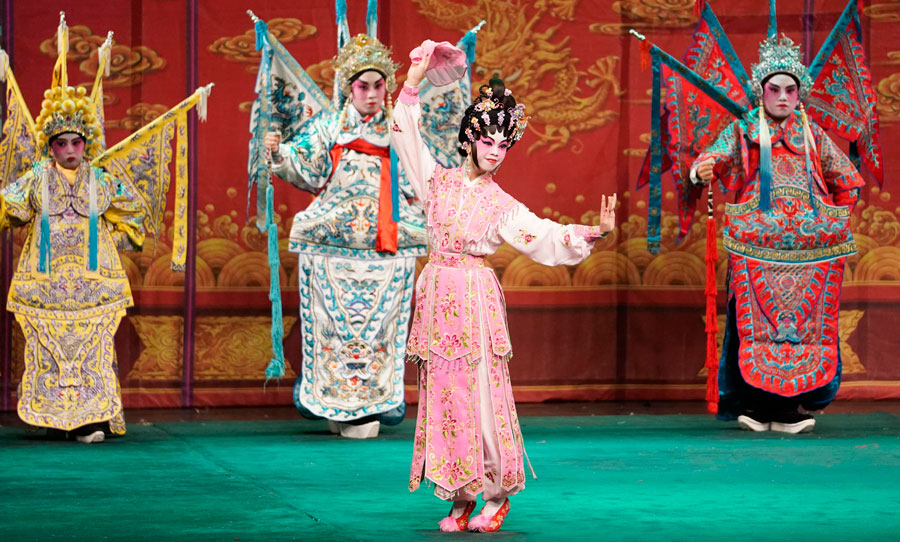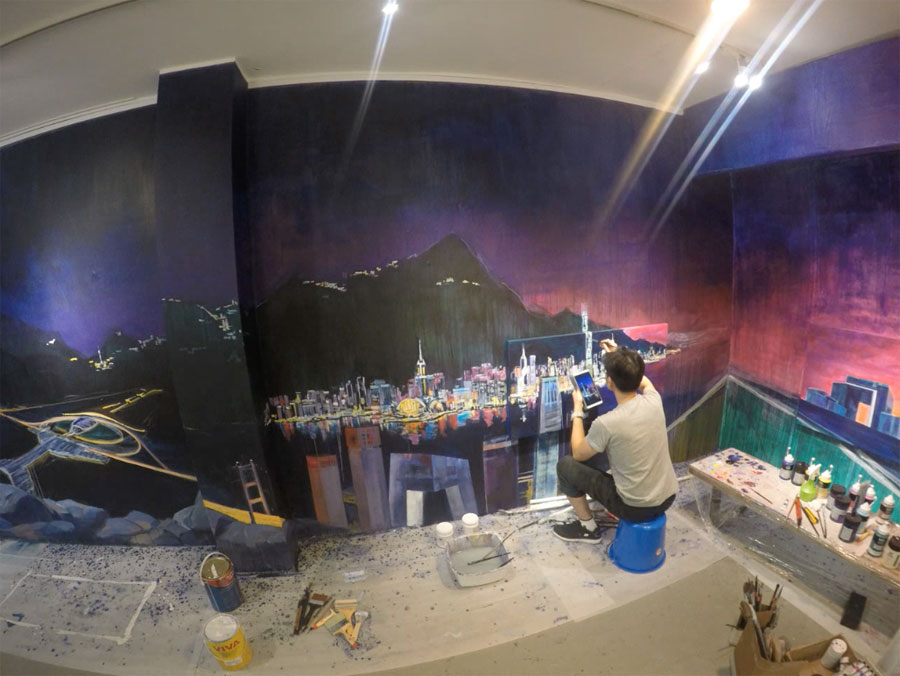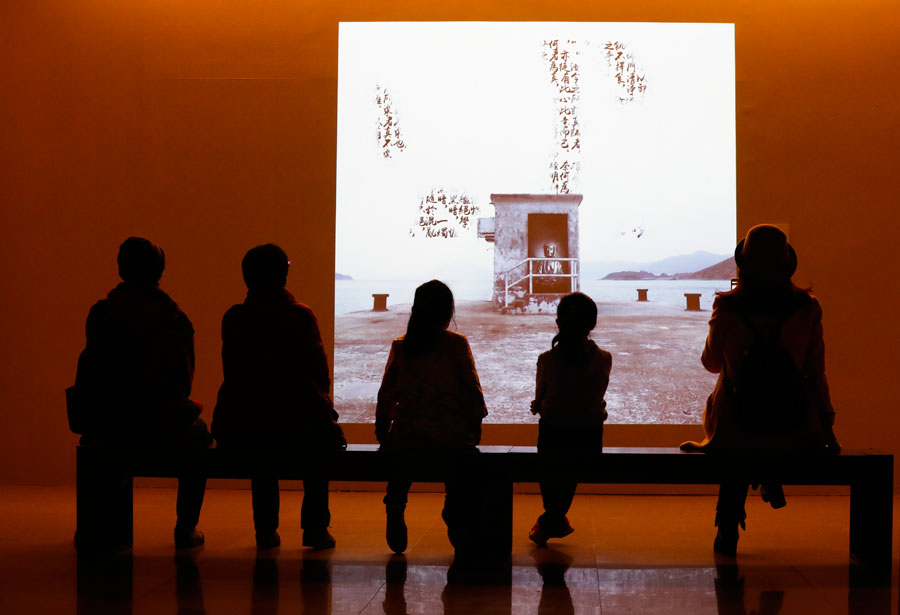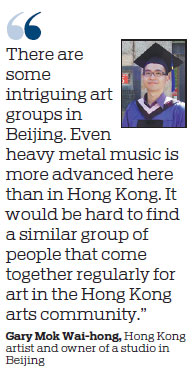
Young artists from the Sing Fai Cantonese Opera Promotion Association in Hong Kong perform classical works in Beijing in July.Du Yang / China News Service
Feeling stifled at home, many members of Hong Kong's artistic community are moving to Beijing and other mainland cities, where audiences are eager to explore innovative ideas and performances.
Beijing is experiencing an immigration boom of sorts, as artists from Hong Kong head to the city in search of opportunities they are unlikely to find at home.
The exodus has been spurred by increasing artistic freedom in the capital and the government's preferential policies for artists, not to mention the Chinese mainland's huge market for visual and performing arts.
In Hong Kong, Gary Mok Waihong was just a wannabe artist. He loved art, but was never going to make it in his home city.
Today, he owns a studio in Beijing and is a full-time artist and curator of shows, including exhibitions in Hong Kong, Macao and the mainland.
He worked hard to get where he is. After many years of study, he completed preparations for art school in time to become one of the first students from Hong Kong to graduate from the bachelor's program at the Central Academy of Fine Arts, China's leading visual arts institute, in 2007.
Having arrived in Beijing in 2000, Mok revels in a cultural melting pot, where new ideas are embraced with enthusiasm and curiosity, and people with diverse talents have the opportunity to express themselves and develop.
"There are some intriguing art groups in Beijing. Even heavy metal music is more advanced here than in Hong Kong. It would be hard to find a similar group of people that come together regularly for art in the Hong Kong arts community," he said.
Much changed in the years after his arrival. Other "creatives" followed his path to find their place in Beijing's artistic community, including painters, dancers, singers, actors and screenwriters.
The process is continuing as young hopefuls arrive in search of opportunities unavailable at home.

Dance teacher Tsang Tsz-kin practices contact improvisation, a modern dance form, with one of the students in his class in Beijing in December.Miriam Zhang / China Daily
A broader path
Mok always dreamed of being an artist, but the nearest he got in Hong Kong was working for a design company.
In 1995, when he graduated from high school, he applied to the Chinese University of Hong Kong, the only school in the city that offered a program in visual arts. However, he failed the Chinese-language exam, so he wasn't chosen.
Later, he was desperate to attend the prestigious academy in Beijing, but at the time it wasn't taking students from Hong Kong.
Even after Hong Kong returned to the motherland in 1997, there were no openings for the city's students at the academy.
The restrictions were lifted in 2001, when new policies opened the doors to young artists from Hong Kong and Macao.
Mok finally had his chance, but he had to demonstrate that he had talent.
He was assessed in sketching, speed drawing and color blending - the prerequisites for admission - but he really wasn't ready for all that.
As far as he was concerned, he was a lowly office worker at a design company with no formal art education, and he would be competing for a place alongside students from across China, many of whom had been honing their skills all their lives.
He failed to gain a place, so he signed up for remedial classes. "I was the only student from Hong Kong, and also the most senior," he recalled, adding that the other students, who were all much younger, called him "uncle."
It was three years before Mok mastered the requisite skills. Having finally been accepted by the academy, he swept through his bachelor's degree and went on to study for a master's.

Artist Gary Mok Wai-hong creates a wall painting at a gallery in Hong Kong in November 2017.Provided To China Daily
Easier access
Today, students from Hong Kong who want to follow their art school dream have an easier ride because institutions across the mainland welcome promising young people from the city.
According to the Office of the Government of the Hong Kong Special Administrative Region of the People's Republic of China in Beijing, about 70 students from the city are enrolled at the three top art schools on the mainland: the Central Conservatory of Music; the Central Academy of Drama; and the Central Academy of Fine Arts.
The number of students is expected to rise after the three schools joined the Scheme for Admission of Hong Kong Students to Mainland Higher Education Institutions this year.
Under the program, students from Hong Kong can apply directly to the three schools.
Provided they pass the auditions or assessments, they will simply have to submit their results from the Hong Kong Diploma of Secondary Education Examination as part of their application.
By the start of the year, 112 mainland universities had signed up for the program, 10 more than last year. The program has seen 10,185 Hong Kong students enroll since it started in 2012, with most studying finance, medicine and engineering.
Gong Wan, director of the China Education Exchange (Hong Kong) Centre, expects to see a rise in the number of students from Hong Kong applying to mainland arts institutions.
Speaking at an education expo in Hong Kong in February, Zhang Feiran, from the admissions office of the Central Academy of Drama, said the school received 50 applications from Hong Kong at the beginning of the current academic year, and seven applicants were offered places.
Next year, under the education exchange program, the number of applicants from Hong Kong is expected to at least double.

Visitors watch a video at an exhibition of works by artist Lui Shou-kwan, organized by the National Art Museum of China and Art Museum CUHK in March last year.Du Yang / China News Service
Wider acclaim
In Beijing, the enthusiasm for novelty has opened doors for niche artists such as Tsang Tsz-kin, who teaches contact improvisation, a form of modern dance.
Having accompanied his wife when she was transferred to Beijing from Hong Kong two years ago, Tsang initially resigned himself to being a stay-at-home house husband.
Instead, he runs a contact improvisation workshop, and attracts new students by promoting his program through social media platforms such as WeChat.
"I teach eight classes every week. That would never have happened in Hong Kong." he said.
The numbers tell the story. For example, in 2017, the gross take for performing arts at box offices across the mainland was 17.6 billion yuan ($2.57 billion), while in Hong Kong it was HK$506 million ($64.5 million), according to the China Association of Performing Arts and the Hong Kong Arts Development Council.
After graduating from the Hong Kong Academy for Performing Arts, Tsang opened his own studio to teach performance art in the city. Although he did pretty well, he grew weary of the repetitive teaching routine. "Being a teacher became a job, not a career." he said.
He became involved with contact improvisation 20 years ago, regarding the form as a way of liberating dancers from repetitive gestures by replacing them with movements between people in contact.
Tsang found it hard to promote the dance form at home. "It wasn't until I left Hong Kong that I realized people there are very conservative," he said.
He added that some of his students seemed more concerned with winning awards than performing dance moves.
In addition, he found that Hong Kong audiences didn't really appreciate his art.
According to the Hong Kong Annual Arts Survey report, published in November by the Hong Kong Arts Development Council, audience numbers at dance performances in the city were the lowest among all forms of performance art, including music, theater and opera.
The numbers fell for five consecutive years, from 271,000 in 2012 to 213,000 in 2017.
Tsang has experienced big changes during his two years in Beijing, where audiences are enthusiastic and enjoy his contact improvisation dance.

"If they don't know about a new thing, they are willing to learn and figure it out." he said.
He has become active in the mainland's contact improvisation community: "I know this dance form is drawing audiences in big cities in addition to Beijing, such as Shanghai, Hangzhou, capital of Zhejiang province, and Chongqing."
He has also been impressed by the receptiveness of audiences in lower-tier cities. He recalled the time he was invited to share his skills at a workshop in Xi'an, capital of Shaanxi province, one of the biggest cities in northwest China.
Many of those attending had traveled from smaller cities, such as Lanzhou, capital of Gansu province, and Yinchuan, capital of the Ningxia Hui autonomous region.
"Those people were willing to spend more than two days traveling to another city just to learn about something new. That was really precious," Tsang said.
Deeper cooperation
In July, the China National Arts Fund announced that practitioners from Hong Kong, Macao and Taiwan had been invited to apply for financial support, which could amount to as much as 4 million yuan per project.
The practitioners are also eligible for training programs subsidized by the fund, while arts organizations on the mainland are being encouraged to work with Hong Kong's art institutions to promote creative synergy and cultural exchanges.
Established in 2013, the arts fund has awarded 11.3 million yuan through seven art exchange projects related to Hong Kong, and artists from the city have participated in 15 national projects supported by the funding.
In 2017, Cheng Shing-tai, a 42-year-old conductor from Hong Kong, joined a project at the Central Conservatory of Music in Beijing.
The monthlong program gave him the opportunity to work with 17 musicians from different provinces and with the China National Traditional Orchestra, the country's leading ensemble of its kind.
Cheng was the only student in his master's class for conductors of Chinese music at the Hong Kong Academy for Performing Arts.
"Our faculty was established in 2011, but the education facilities and teaching resources are relatively poor," he said. The exchange project gave him more opportunities to practice his skills.
Cheng was excited when he learned the national funding was open to artists from Hong Kong, and said he would definitely apply if he could find suitable projects.
Nurturing cultural talent and promoting exchanges among arts groups have been written into the blueprint for the development of the Guangdong-Hong Kong-Macao Greater Bay Area, which was released by the Central Committee of the Communist Party of China and the State Council, China's Cabinet, in February.
In the meantime, local artists will continue to cross the border to seek their fortunes on the mainland.

